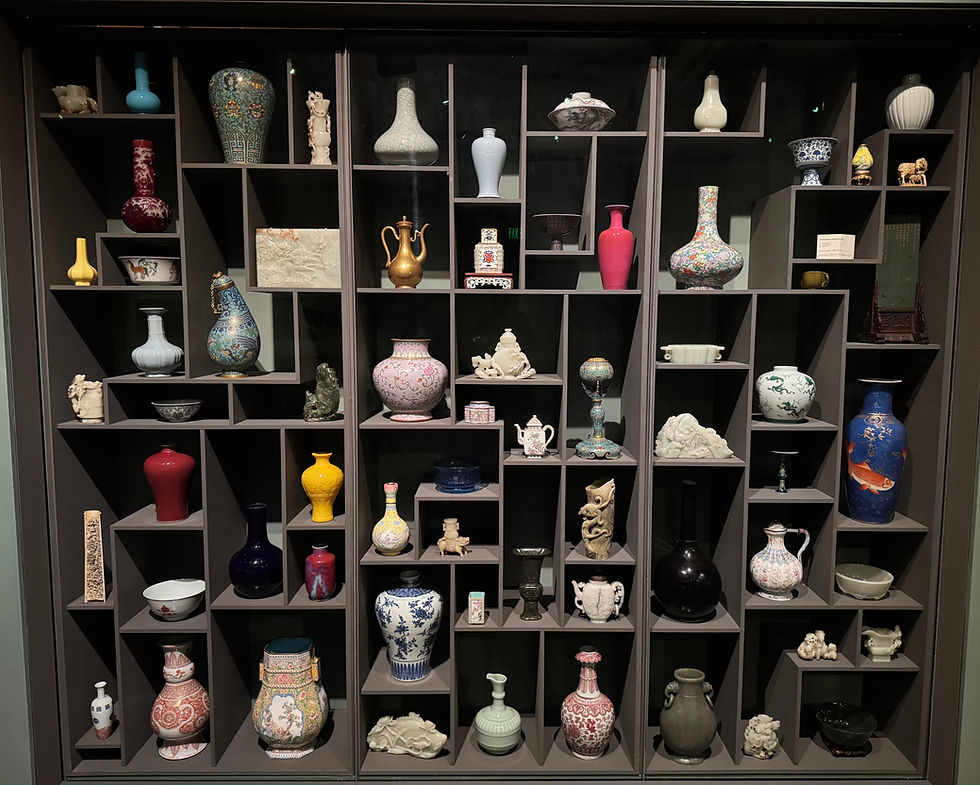Hokusai's $690,000 Record-Breaking 'Great Wave Off Kanagawa' @Heffel Toronto
- Anthony Wu

- Apr 29, 2022
- 4 min read
Updated: Feb 20, 2025
I just completed my third Asian art auction at Heffel! This was an online sale that started on April 7 and closed on April 28.
Spanning two sessions titled Fine Asian Paintings & Works on Paper and Fine Asian Works of Art, the auction featured just over sixty objects from China, Japan, India and the Himalayan region.
A big thank you for those of you who were able to attend the preview in the Heffel Toronto, Vancouver or Montreal galleries, and an even bigger THANK YOU for those of you who left bids. The majority of the objects up for sale found new homes and the overall sale realized just under CAD 1 million.
Many categories in the auction were featured including Chinese paintings, porcelain, jade carvings, scholar objects and furniture, in addition to Japanese woodblock prints and paintings, and Himalayan and Indian sculpture.
By far the top seller and highlight was lot 003, the Japanese woodblock print artist Katsushika Hokusai's (1760-1849) 'Under the Well of the Great Wave Off Kanagawa'. Simply known as 'The Great Wave', this is Hokusai's most famous woodblock print, and probably one of the most iconic works of art on the planet.
Published circa 1831 when the artist was 70 years old, 'The Great Wave' is from Hokusai's seminal series “The 36 Views of Mt. Fuji,” a publication of ukiyo-e ('floating world') prints focuses on Japan’s tallest and holiest mountain, Fujiyama, viewed in different times of the days, seasons, weather conditions, and vantage points.

Image 1. An image of Hokusai's 'The Great Wave' sold at Heffel on April 28.
Selling 'The Great Wave' was one of the highlights of my entire 18 year career in the Asian art field. There were numerous bids within hours of the sale being uploaded onto the Heffel website. After three weeks of competing bids from all over the world, 'The Great Wave' ended up selling for CAD 691,250 including buyer's premium.

Image 2. A photo of me holding 'The Great Wave' during the exhibition at Heffel's Toronto gallery.
The provenance of 'The Great Wave' is remarkable. It was passed down through the descendants of R. A. Laidlaw, a well-known Toronto businessman and philanthropist during the early 20th Century.

Image 3. A photo of me CAREFULLY examining 'The Great Wave' when it arrived at the Heffel Toronto gallery. Some of the things I had to look out for was the authenticity (obviously), the quality of the paper and the condition.
For authentic versions of 'The Great Wave' that was produced circa 1831 - of which approximately 5,000 to 7,000 images was thought to be made during the first printing - the sequence of which each print was produced was critical. Earlier versions of the print are significantly more valuable than later prints in the sequence.

Image 4. A photo of me wearing my 'Great Wave' T-shirt at the intersection of Avenue Rd and Yorkville Ave in downtown Toronto. Heffel put together a massive poster of the woodblock print during the weeks it was on view in April.
This was one of the most spectacular Asian art projects I have worked on. Not only was 'The Great Wave' the most expensive Japanese artwork I helped to sell, but it also set the Canadian record for a Japanese artwork ever sold in Canada.
Another wonderful item that I sold during the Heffel April online sale of Asian art was a well-carved Chinese spinach green jade dragon seal.

Image 5. A view of the impressive Chinese spinach green jade dragon seal sitting on my desk during the April Asian art online sale at Heffel.
I wrote a little bit about this jade seal in an earlier post. In my research, this seal was carved during the late 19th Century as an homage to a set made for the Chinese Emperor Qianlong (reign 1736-1795) during the 1780's.
The seal was acquired in London from important dealer John Sparks in 1933 by Enid Strathearn Hendrie Owen, a major collector of Chinese jade carvings from the Neolithic Period to the Qing Dynasty. While the majority of her works were donated to the Montreal Museum of Fine Arts, this seal remained in her family and was passed down to her descendants in Quebec.

Image 6. A photo of the jade seal's base with the Chinese characters 五福五代堂寶 'wu fu wu dai tang bao', which translates to 'The Hall of Five Happiness and Five Generations.'
Original versions of this seal was used to commemorate certain milestones in Emperor Qianlong's life in 1780. In addition to turning 70 years old, he also wanted to mark his 45 years on the Imperial throne. In 1784, the Qianlong Emperor also had his first great-great-grandson. As a result, he commissioned a set of nine seals of various sizes with the inscription ‘wu fu wu dai tang bao’ – Treasure from the Hall of the Five Blessings and Five Generations.
This spinach green jade seal had a lot of interest from Toronto and Vancouver Chinese art collectors. It ended up selling for a very strong CAD 91,250 including buyer's premium, against an estimate of CAD 30,000/40,000.
April was a very exciting month for me at Heffel auctions. The sale saw many great results and I was fortunate with working with such a great team. The next Heffel Asian art sale is scheduled for October of 2022, so I'll be hard at work in the coming months sourcing fresh Asian art objects. In addition to my home base of Toronto, I'll also be traveling a lot and working on Asian art appraisals in Vancouver, Montreal and Ottawa.




Comments